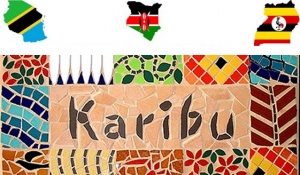Language/Swahili-individual-language/Culture/Music-and-Dance
| ◀️ Food and Drink — Previous Lesson | Next Lesson — Religion and Beliefs ▶️ |
As a Swahili language teacher for 20 years, I have seen firsthand how knowledge of a culture can enhance one's understanding of a language. In the case of Swahili, music and dance are essential elements of the culture, and learning more about them can bring a greater richness to your studies. In this lesson, we will explore the traditional music and dance of the Swahili people.
Don't miss the chance to check out these pages as you wrap up this lesson: Popular Culture & Maji and the Maridadi.
Music
Swahili music is a fusion of various influences, including Arabic, Indian, and African styles. The result is a unique sound that is truly representative of the East African coast. Some of the most popular types of music include:
- == Taarab ==*
Taarab is a traditional musical genre that originated in Zanzibar in the early 20th century. It is characterized by a mixture of Arabic and Swahili lyrics, accompanied by a variety of instruments, including violins, qanuns, and ouds. Taarab is often performed at weddings and other important cultural events, and its slow tempo encourages people to dance with grace and elegance.
- == Chakacha ==*
Chakacha is a lively dance music that has its origins in the coastal region of Kenya. The basic rhythm of chakacha is created by a drummer who beats a rhythm on a single drum while the singers and dancers respond with their voices and bodies. The syncopated sound of the chakacha rhythm is infectious, and it is impossible to resist the urge to join in and dance.
- == Benga ==*
Benga is a fast-paced, upbeat style of music that originated in the 1940s in the western region of Kenya. It is often played on electric guitars and drums, accompanied by call-and-response vocals. Benga was initially associated with young urbanites, but it has since become a popular genre throughout East Africa.
Dance
Dance is an integral part of Swahili culture, and it is often used to express joy, sadness, and other emotions. Many traditional Swahili dances have been passed down through the generations and are still performed today. Some of the most popular dances include:
- == Chakacha ==*
As mentioned earlier, chakacha is not only a type of music but also a dance. The dance involves hip swinging and gyrating as performers move to the infectious rhythm of the music.
- == Bao ==*
Bao is a traditional Swahili dance that has its origins in the Tanga region of Tanzania. It is a dance of celebration and typically involves groups of people moving in a circular motion around a central point. The dancers often wear brightly colored robes and scarves, which accentuate their movements.
- == Ngoma ==*
Ngoma is a generic term used to describe traditional African dances. In Swahili culture, ngoma is often used to describe a type of communal dance that involves a group of performers moving to the beat of drums and other percussion instruments. The dance is characterized by loose, fluid movements and an emphasis on rhythm and timing.
Conclusion
Music and dance are two essential elements of Swahili culture, and understanding them can help you gain a deeper appreciation for the language. Taarab, chakacha, and benga are just a few examples of the many types of Swahili music, while chakacha, bao, and ngoma are just a few examples of the many traditional Swahili dances. By learning more about these art forms, you can gain a greater understanding of the rich and vibrant culture of the Swahili people.
| Swahili (individual language) | Pronunciation | English |
|---|---|---|
| Taarab | ta-raab | A traditional musical genre that originated in Zanzibar in the early 20th century, characterized by a mixture of Arabic and Swahili lyrics, accompanied by a variety of instruments, including violins, qanuns, and ouds. |
| Chakacha | cha-ka-cha | A lively dance music that has its origins in the coastal region of Kenya. |
| Benga | ben-ga | A fast-paced, upbeat style of music that originated in the 1940s in the western region of Kenya. |
| Bao | bah-o | A traditional Swahili dance that has its origins in the Tanga region of Tanzania. |
| Ngoma | n-go-ma | A generic term used to describe traditional African dances, often used to describe a type of communal dance in Swahili culture. |
Congratulations on finishing this lesson! Explore these related pages to keep learning: Kenya Timeline & Ramadan and Eid al Fitr.
Other Lessons
- Sherehe za Mapinduzi
- Religion and Beliefs
- Oral Narratives
- Contemporary Literature
- History of Swahili
- Food and Drink
- Kenya Timeline
- Weddings and Marriage
- Ramadan and Eid al Fitr
- Popular Culture
| ◀️ Food and Drink — Previous Lesson | Next Lesson — Religion and Beliefs ▶️ |

